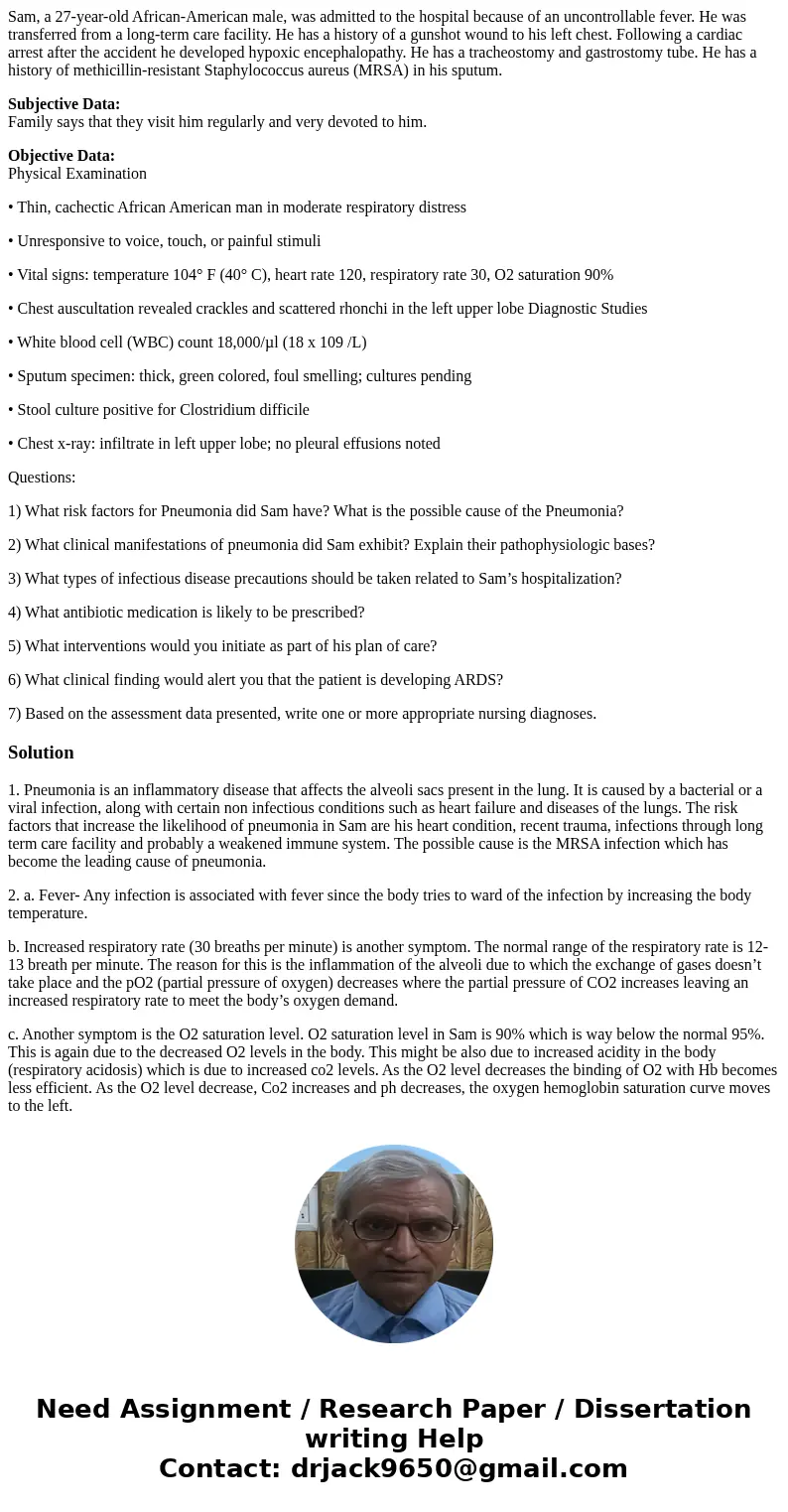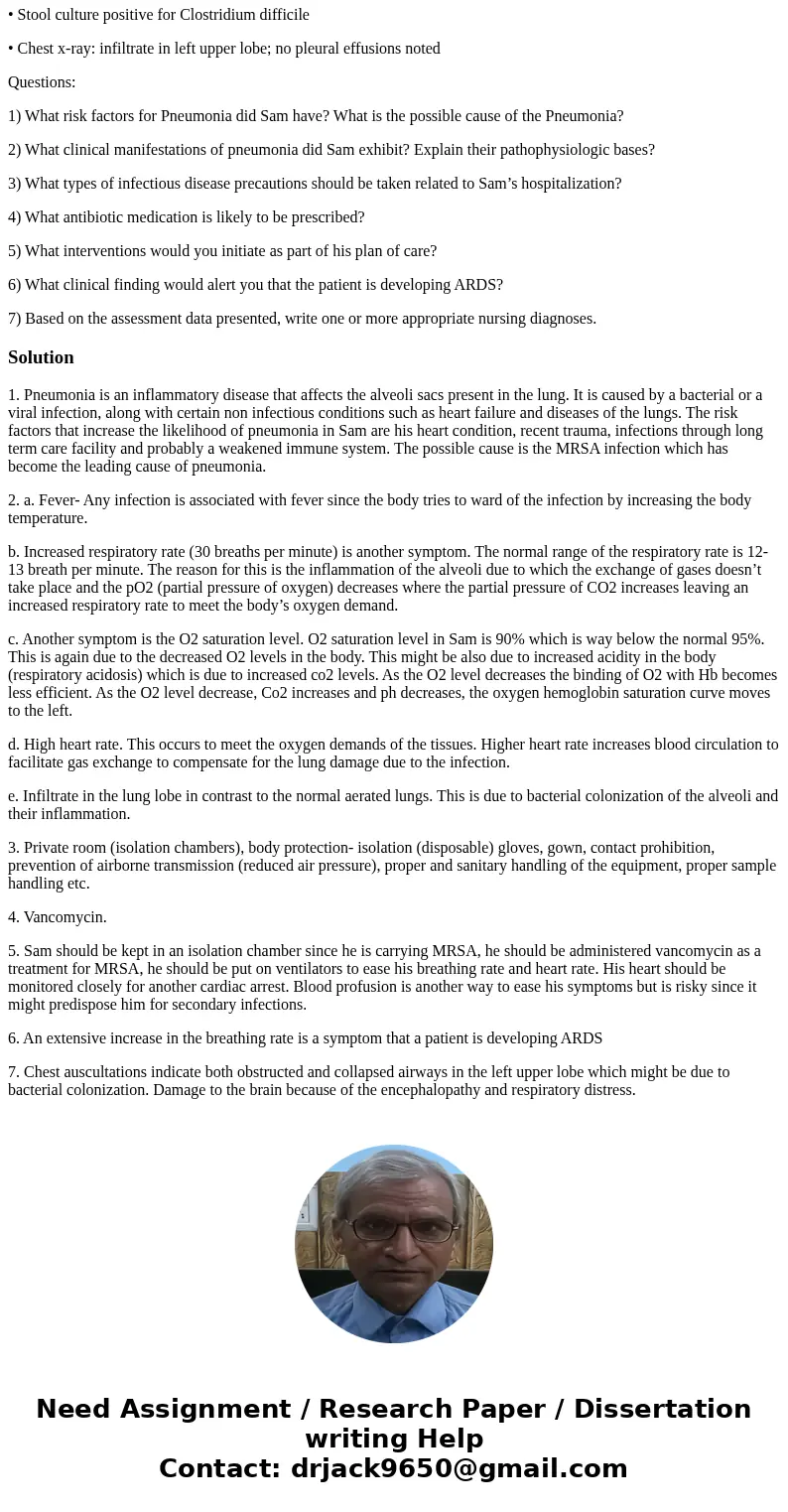Sam a 27yearold AfricanAmerican male was admitted to the hos
Sam, a 27-year-old African-American male, was admitted to the hospital because of an uncontrollable fever. He was transferred from a long-term care facility. He has a history of a gunshot wound to his left chest. Following a cardiac arrest after the accident he developed hypoxic encephalopathy. He has a tracheostomy and gastrostomy tube. He has a history of methicillin-resistant Staphylococcus aureus (MRSA) in his sputum.
Subjective Data:
Family says that they visit him regularly and very devoted to him.
Objective Data:
Physical Examination
• Thin, cachectic African American man in moderate respiratory distress
• Unresponsive to voice, touch, or painful stimuli
• Vital signs: temperature 104° F (40° C), heart rate 120, respiratory rate 30, O2 saturation 90%
• Chest auscultation revealed crackles and scattered rhonchi in the left upper lobe Diagnostic Studies
• White blood cell (WBC) count 18,000/µl (18 x 109 /L)
• Sputum specimen: thick, green colored, foul smelling; cultures pending
• Stool culture positive for Clostridium difficile
• Chest x-ray: infiltrate in left upper lobe; no pleural effusions noted
Questions:
1) What risk factors for Pneumonia did Sam have? What is the possible cause of the Pneumonia?
2) What clinical manifestations of pneumonia did Sam exhibit? Explain their pathophysiologic bases?
3) What types of infectious disease precautions should be taken related to Sam’s hospitalization?
4) What antibiotic medication is likely to be prescribed?
5) What interventions would you initiate as part of his plan of care?
6) What clinical finding would alert you that the patient is developing ARDS?
7) Based on the assessment data presented, write one or more appropriate nursing diagnoses.
Solution
1. Pneumonia is an inflammatory disease that affects the alveoli sacs present in the lung. It is caused by a bacterial or a viral infection, along with certain non infectious conditions such as heart failure and diseases of the lungs. The risk factors that increase the likelihood of pneumonia in Sam are his heart condition, recent trauma, infections through long term care facility and probably a weakened immune system. The possible cause is the MRSA infection which has become the leading cause of pneumonia.
2. a. Fever- Any infection is associated with fever since the body tries to ward of the infection by increasing the body temperature.
b. Increased respiratory rate (30 breaths per minute) is another symptom. The normal range of the respiratory rate is 12-13 breath per minute. The reason for this is the inflammation of the alveoli due to which the exchange of gases doesn’t take place and the pO2 (partial pressure of oxygen) decreases where the partial pressure of CO2 increases leaving an increased respiratory rate to meet the body’s oxygen demand.
c. Another symptom is the O2 saturation level. O2 saturation level in Sam is 90% which is way below the normal 95%. This is again due to the decreased O2 levels in the body. This might be also due to increased acidity in the body (respiratory acidosis) which is due to increased co2 levels. As the O2 level decreases the binding of O2 with Hb becomes less efficient. As the O2 level decrease, Co2 increases and ph decreases, the oxygen hemoglobin saturation curve moves to the left.
d. High heart rate. This occurs to meet the oxygen demands of the tissues. Higher heart rate increases blood circulation to facilitate gas exchange to compensate for the lung damage due to the infection.
e. Infiltrate in the lung lobe in contrast to the normal aerated lungs. This is due to bacterial colonization of the alveoli and their inflammation.
3. Private room (isolation chambers), body protection- isolation (disposable) gloves, gown, contact prohibition, prevention of airborne transmission (reduced air pressure), proper and sanitary handling of the equipment, proper sample handling etc.
4. Vancomycin.
5. Sam should be kept in an isolation chamber since he is carrying MRSA, he should be administered vancomycin as a treatment for MRSA, he should be put on ventilators to ease his breathing rate and heart rate. His heart should be monitored closely for another cardiac arrest. Blood profusion is another way to ease his symptoms but is risky since it might predispose him for secondary infections.
6. An extensive increase in the breathing rate is a symptom that a patient is developing ARDS
7. Chest auscultations indicate both obstructed and collapsed airways in the left upper lobe which might be due to bacterial colonization. Damage to the brain because of the encephalopathy and respiratory distress.


 Homework Sourse
Homework Sourse